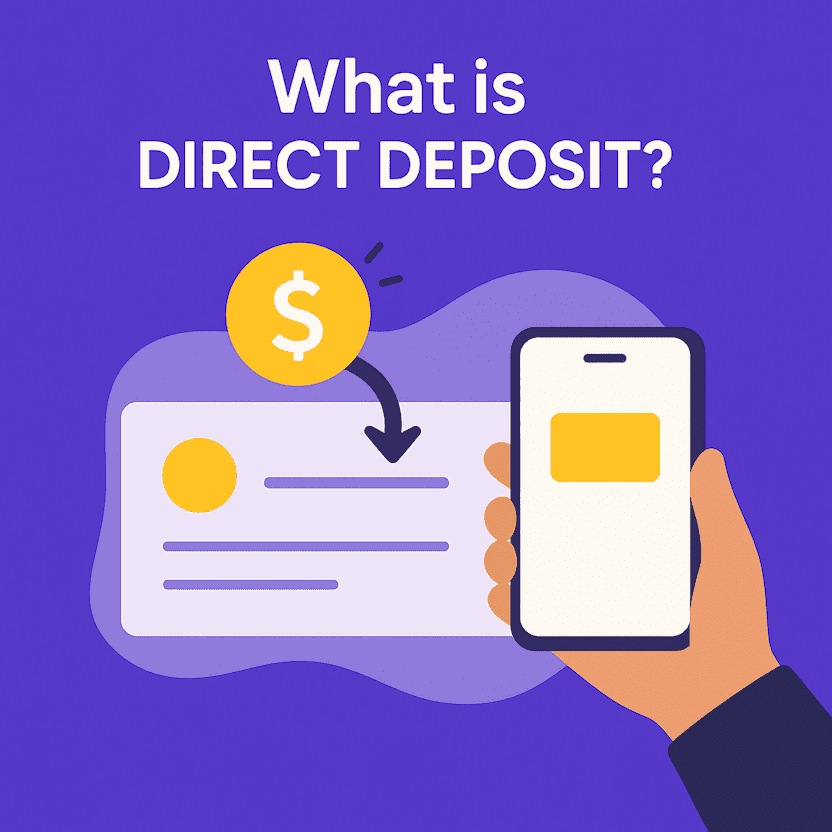Advertiser Disclosure
Last update: October 29, 2025
7 minutes read
What Is Direct Deposit, and How Do I Set It Up?
Need to get paid faster and easier? Learn what direct deposit is, how it works, and how to set it up for your job, scholarships, or refunds in just a few simple steps.

By Derick Rodriguez, Associate Editor
Edited by Yerain Abreu, M.S.
Learn more about our editorial standards



By Derick Rodriguez, Associate Editor
Edited by Yerain Abreu, M.S.
Learn more about our editorial standards
Getting paid shouldn't feel like a hassle. If you're tired of waiting for paper checks or making trips to the bank, direct deposit might be exactly what you need.
Whether you're working part-time, receiving financial aid refunds, or getting scholarship money, understanding how direct deposit works can save you time and stress.

Key takeaways
- Direct deposit electronically transfers money straight into your bank account without paper checks
- You'll need your bank account and routing numbers to set it up with an employer or school
- Most direct deposits arrive within 1-2 business days, often faster than traditional checks
What is direct deposit?
Direct deposit is an electronic payment method that sends money straight from a payer (like your employer or school) into your bank account. No paper checks involved. The money shows up automatically on payday, usually early in the morning, and you can use it right away.
Think of it like a digital highway for your money.
The system uses the Automated Clearing House (ACH) network, which is a secure way banks move money between accounts. When your boss or school sends a payment, the ACH network processes it and puts the funds where they belong.

TuitionHero Tip
Direct deposit isn't just for paychecks. You can use it for tax refunds, government benefits, scholarship payments, and student loan refunds from your school.
So, ultimately, direct deposit makes life simpler, especially when you're juggling school and work. Here's why it matters:
- No more bank runs: Your money arrives automatically. No rushing to the bank between classes.
- Faster access: Money hits your account quicker than mailed checks that take days to arrive and process.
- Works anywhere: Studying abroad or traveling during break? Your payment still reaches you.
- Safer: Can't lose a digital deposit like you can lose a paper check.
- Free: Setting it up costs nothing.
If you've ever lost a paper check or had one stolen, you know the headache of getting a replacement. Direct deposit eliminates that stress completely.

What information do you need to set it up?
You need three things from your bank account:
- Account number: This identifies your specific account. It's usually 10-12 digits long. You can find it on your checks or by logging into your bank's website or app.
- Routing number: This tells the system which bank you use. It's always exactly nine digits. Also on your checks or in your online banking info.
- Account type: Just whether you're using checking or savings. Most people pick checking because it's easier for everyday spending.
Some places might also ask for a voided check or a letter from your bank to prove your account is real. If you don't have paper checks (lots of people don't anymore), your bank can print out a verification letter for you.

TuitionHero Tip
Check your numbers twice before submitting. One wrong digit sends your money to the wrong place, and fixing it is a pain.
Where to find your banking numbers
Information Needed | Where to Find It | What It Looks Like |
|---|---|---|
Routing Number | Bottom of check (first set of numbers) or bank app | 9 digits (example: 123456789) |
Account Number | Bottom of check (second set of numbers) or bank app | 10-12 digits (example: 9876543210) |
Account Type | You choose this | Either "Checking" or "Savings" |
How to set up direct deposit with your employer
Setting up direct deposit at work is pretty straightforward:
- Step 1 - Get the form Ask your HR or payroll department for a direct deposit form. Many companies let you fill it out online through their payroll system.
- Step 2 - Fill in your bank details Enter your routing number, account number, and account type. Attach a voided check or bank letter if they ask for it.
- Step 3 - Submit and wait Turn in the form. Your first paycheck or two might still be paper checks while everything gets set up. This usually takes 1-2 pay periods.
- Step 4 - Confirm it worked Check your bank account on payday to make sure the money arrived.
Some employers let you split your paycheck between accounts. This is useful if you want to automatically put some money into savings every time you get paid.
Compare private student loans now
TuitionHero simplifies your student loan decision, with multiple top loans side-by-side.
Compare Rates
How to set up direct deposit for financial aid refunds
Most colleges make this easy through their student portal:
- Log into your school's website
- Find the section called "Financial Aid," "Student Accounts," or "Billing"
- Look for "Direct Deposit" or "Refund Preferences"
- Enter your banking information
- Save and confirm
Your school might try to get you to open an account with a specific bank they partner with. You don't have to. You can use any regular bank or credit union you want.
Just do this before the semester starts. Financial aid offices get super busy during the first few weeks of school, and you don't want delays.

TuitionHero Tip
Refund timing is different at every school. Some send money a few days after classes start, others take several weeks. Ask your financial aid office when to expect your refund.
How long does direct deposit take?
Most direct deposits show up within 1-2 business days after they're sent. Many employers time it so your money appears exactly on payday, even if payday is on a weekend.
Here's a typical timeline:
- Day 1: Employer or school sends the payment
- Day 1-2: Your bank shows it as "pending"
- Day 2-3: Money becomes available to spend
Your first deposit might take a little longer because banks verify new connections. After that, everything runs smoothly.
What if something goes wrong?
Problems are rare, but here's what to do:
Your deposit didn't arrive
- Check your bank app to see if it's pending
- Contact whoever was supposed to pay you
- They can track the payment and tell you what happened
Wrong account number
- Tell the payer and your bank immediately
- They might be able to reverse it if you're quick
Bank put a hold on your money
- This happens sometimes with large deposits or new accounts
- The money is safe, you just can't use it yet
- Call your bank if the hold lasts more than 2-3 days
Do you have to use direct deposit?
No, but paper checks are becoming less common. Some companies don't offer them anymore because direct deposit is cheaper and easier to manage.
If you don't have a bank account yet, that's the first thing to fix. Most banks offer free checking accounts for students. You'll need one for financial aid, saving money safely, and building credit later on.
Can you split your direct deposit?
Yes! Many employers let you divide your paycheck across different accounts. This is great for saving automatically.
Here's an example:
- 80% goes to checking for bills and spending
- 20% goes to savings for emergencies
You can usually pick either a specific dollar amount or a percentage for each account.
Schools typically don't offer this for refunds, but you can always move money between your own accounts after the refund shows up.
Common direct deposit mistakes to avoid
Mistake | Why It's a Problem | How to Fix It |
|---|---|---|
Wrong account number | Money goes to someone else's account | Double-check before submitting |
Closing old account too soon | Payment gets rejected and bounces back | Keep old account open until new direct deposit works |
Using a savings account for everything | Some banks limit savings withdrawals | Use checking for regular deposits |
Not updating address with bank | You might miss important bank notices | Update your info when you move |
What happens if you close your bank account?
Tell your employer or school before you close an account that receives direct deposits. If a payment tries to go to a closed account, the bank sends it back. You'll still get your money, but it takes extra time and might come as a paper check.
Give yourself at least two weeks to update everything. It takes time for payroll systems to process changes.

Why trust TuitionHero
At TuitionHero, we help you find the best private student loans by comparing top lenders and breaking down eligibility, interest rates, and repayment options. Whether you need additional funding beyond federal aid or a loan without a cosigner, we simplify the process. We also provide expert insights on refinancing, FAFSA assistance, scholarships, and student credit cards to support your financial success.
Frequently asked questions (FAQ)
No, it's completely free. Your employer or school pays any processing fees, and your bank shouldn't charge you for receiving deposits. If your bank does charge for this, find a better bank.
You can use savings, but checking is better for money you'll spend regularly. Some banks limit how many times you can withdraw from savings each month. If you don't want a traditional bank, credit unions and online banks often have great student accounts with no fees.
First, check your bank app to see if it's pending. If you don't see anything, contact your employer or school's payroll office. They can track where the payment went. Banking errors are fixable if you report them fast.
It's pretty hard. Banks have fraud protection that flags weird activity. Still, be smart about who you share your banking info with. Only give it through official, secure channels.
Check the bottom of a paper check: the routing number is first (9 digits), the account number is next. No checks? Log into your bank's website or app and look for account details. You can also call your bank or stop by a branch.
Final thoughts
Direct deposit takes five minutes to set up and saves you tons of time later. No more waiting for checks in the mail or rushing to the bank before it closes.
Grab your bank account information, fill out the form from your employer or school, and give it a couple weeks to kick in. After that, your money shows up automatically every time without you lifting a finger.
Managing money gets easier when you have the right systems in place. TuitionHero can help you compare financial aid packages, understand student loans, and make smart choices with your refund money. Getting paid efficiently is just the beginning of taking control of your finances.
Source
Author

Derick Rodriguez
Derick Rodriguez is a seasoned editor and digital marketing strategist specializing in demystifying college finance. With over half a decade of experience in the digital realm, Derick has honed a unique skill set that bridges the gap between complex financial concepts and accessible, user-friendly communication. His approach is deeply rooted in leveraging personal experiences and insights to illuminate the nuances of college finance, making it more approachable for students and families.
Editor

Yerain Abreu
Yerain Abreu is a Content Strategist with over 7 years of experience. He earned a Master's degree in digital marketing from Zicklin School of Business. He focuses on college finance, a niche carved out of his journey through the complexities of academic finance. These firsthand experiences provide him with a unique perspective, enabling him to create content that's informative and relatable to students and their families grappling with the intricacies of college financing.
At TuitionHero, we're not just passionate about our work - we take immense pride in it. Our dedicated team of writers diligently follows strict editorial standards, ensuring that every piece of content we publish is accurate, current, and highly valuable. We don't just strive for quality; we aim for excellence.
Related posts
While you're at it, here are some other college finance-related blog posts you might be interested in.
Shop and compare student financing options - 100% free!

Always free, always fast
TuitionHero is 100% free to use. Here, you can instantly view and compare multiple top lenders side-by-side.

Won’t affect credit score
Don’t worry – checking your rates with TuitionHero never impacts your credit score!

Safe and secure
We take your information's security seriously. We apply industry best practices to ensure your data is safe.
Finished scrolling? Start saving & find your private student loan rate today
Compare Personalized Rates


